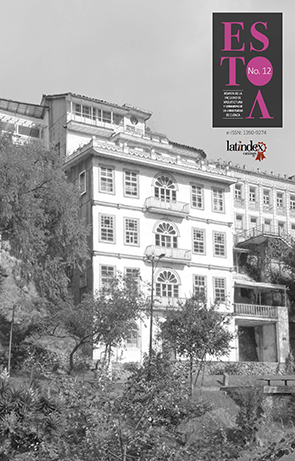The production of earth-based paint as an endogenous resource in the province of Azuay, Ecuador
DOI:
https://doi.org/10.18537/est.v007.n012.a08Abstract
In the canton of Oña exist a considerable diversity of mineral pigments, known as “earth pigments ", with which paints can be made in an artisan way. This research presents the results of the first stage of the “earth pigments” project, whose main objective is to contribute to the knowledge of the production, application and use of earth-based paints in the province of Azuay, for its application in the conservation of heritage as well as in contemporary architecture. To fulfill this objective, testimonies were collected of people and building contractors who use soils in an empirical way for the preparation of artisan paint, and thereby rescuing traditional materials and techniques. The identification of the tones present in the architecture of Oña and Susudel was carried out through the prospecting of a strategicsample, obtaining a palette of historical colors corresponding to the walls of its heritage buildings. This research furthermore proposes a process of territorial entrepreneurship that will have a direct impact on the sectors that historically have been interconnected productively with the use of its soils and that can be linked inherently with other economic activities of the region.
Keywords:Territorial development, cultural entrepreneurship, Oña, mineral pigments, handmade paint, earth pigments.
Downloads
References
Bossier, S. (1999) “Desarrollo (local): ¿De qué estamos hablando?”, Instituto de Geografía Pontificia Universidad Católica de Chile, Chile.
Calle, M. De la, García, M. (2010). Reflexiones sobre el turismo cultural. La aportación de la cultura en la conformación de flujos turísticos emisores en España y la Comunidad de Madrid, Anales de Geografía, 30 (2), pp. 31-58.
Cardoso, F. Moscoso, S. Astudillo, S. Wijffels, A. & Van Valen, K. (2013). From theory to Action, Social Involvement in Rural Built Heritage, in Reflections on Preventive Conservation, Maintenance and Monitoring of Monuments and Sites, pp. 117-122. Acco, Leuven, Belgium.
Colombato, C. & Medici, M. (2016). El derecho humano a los patrimonios culturales en clave decolonial. Revista Brasileira de Sociología do Derecho, v. 3, n. 3, pp. 67-95
Goodman L. (1961).Snowball sampling. Annals of mathematical statistics. Ithaca, UnitedStates of America.
Pitarch, G. M. (2013) La cultura cultura como oportunidad para un desarrollo turístico sostenible. EnLedo, C. A. (1a. Ed.) Turisme cultural, desenvolupament territorial i sostenibilitat (pp. 27-41). Valencia. España. Editorial Universidad de Valencia.
Ray, C., (2003). Governance and the Neo-Endogenous Approach to Rural Development. Centre for Rural Economy, Manuscrito, Newcastle University, UK
Rehren, T. Temme, M. (1994). Pre-Columbian Gold Processing at Putushio, South Ecuador: The archaeometallurgical Evidence. In Archaeometry of Pre- Columbian Sites and Artifacts, pp. 267-284. Los Angeles, USA.
Rosales, V. & Salazar, I. (2017). La tierra de Oña: color, técnica y patrimonio. Tesis de pregrado, Universidad de Cuenca. Ecuador, Cuenca.
Dirección Regional 6 Instituto Nacional de Patrimonio Cultural & Proyecto vlirCPM-Universidad de Cuenca. (2012). Memorias. Plan Piloto de Mantenimiento aplicado en las viviendas de Susudel. Cuenca.
UNESCO. (2010). Saving Our Vanishing Heritage, Global Heritage Fund, Palo Alto, EE. UU.
UNESCO. (2013). Declaración de Hangzhou: Situar la cultura en el centro de las políticas de desarrollo sostenible, Hangzhou, República Popular China.
Vázquez-Barquero, A. (1999). Desarrollo, redes e innovación, Edit. Pirámide, Madrid, España.
Published
How to Cite
Issue
Section
License
The Journal declines any responsibility for possible conflicts derived from the authorship of the works that are published in it.
The University of Cuenca in Ecuador conserves the patrimonial rights (copyright) of the published works and will favor the reuse of the same ones, these can be: copy, use, diffuse, transmit and expose publicly.
Unless otherwise indicated, all contents of the electronic edition are distributed under a Creative Commons Attribution-NonCommercial-ShareAlike 4.0 International License.




